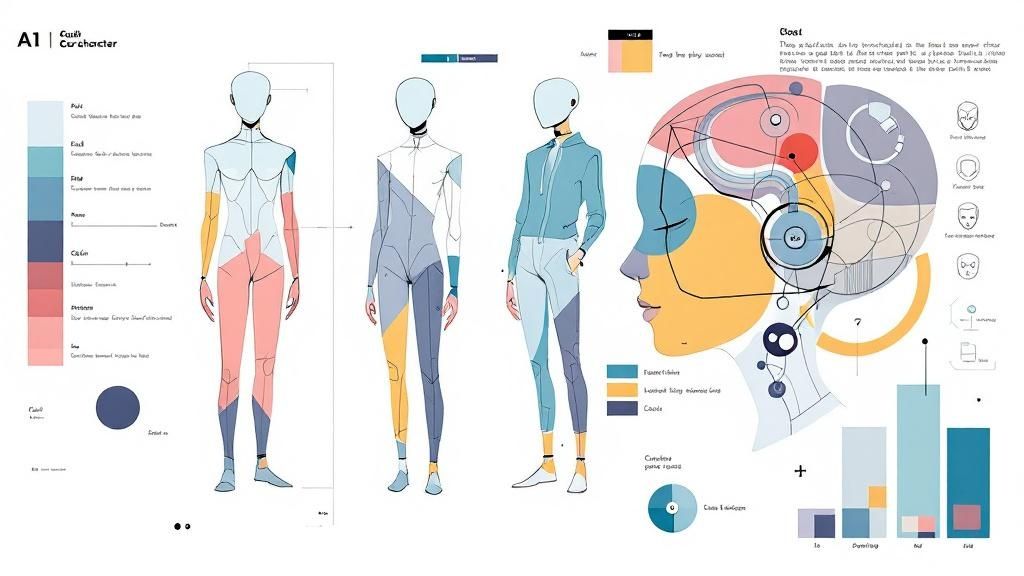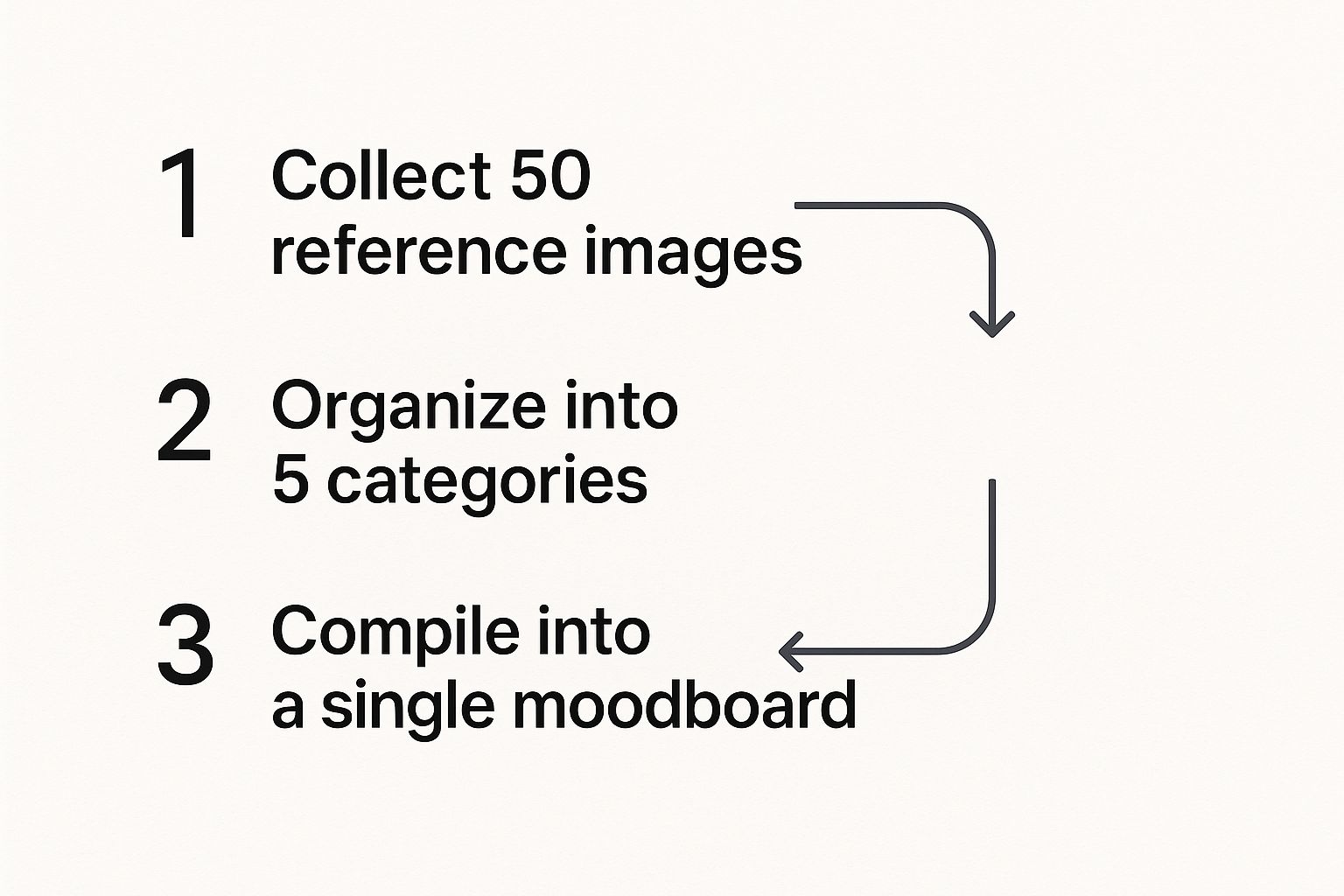Create Your Own AI Girlfriend 😈
Chat with AI Luvr's today or make your own! Receive images, audio messages, and much more! 🔥
4.5 stars

Bringing an AI character to life is less about technical know-how and more about creative storytelling. You're defining a personality, shaping an appearance, and weaving a history to make them feel truly real. Platforms like Luvr AI give you the tools to transform a simple idea into an interactive, digital persona. This process isn't about coding; it's about breathing life into a digital being.
The Art of Digital Creation
So, why do we feel this pull to create AI characters? It taps into our fundamental human need for connection, storytelling, and pure creative expression. It’s not just about playing with smart technology—it’s about crafting a companion, a confidant, or even a fantasy figure who understands and responds to you.
When you create a character, you shift from being a passive observer to an active world-builder. Think of it like a sophisticated form of digital puppetry. You aren't just pulling the strings; you're defining the very soul of the puppet. This process allows for incredible personalization, giving you a private, judgment-free space to explore unique stories and relationships.
Our Fascination with Digital Companions
The appeal of AI characters has exploded, and it’s no longer a niche hobby. This reflects a much bigger shift in how we look to technology for both companionship and entertainment. The growth of platforms in this space has been staggering, proving just how many people are looking to create and connect in this way.
Take Character.ai, for example. After launching in 2021, its user base grew incredibly fast, attracting millions who were eager to design their own digital friends. Its global app downloads have now shot past 40 million, a clear sign of the massive interest in this unique form of interaction. You can dive deeper into these numbers on the character.ai statistics page.
Expert Tip: The most engaging AI characters are the ones with flaws, quirks, and a rich inner world. A perfect character is predictable and, honestly, a little boring. A character with a hidden past or a secret ambition? Now that's fascinating.
Ultimately, building an AI character is a powerful act of self-expression. It’s your chance to:
- Unleash your creativity by designing a personality from the ground up.
- Weave immersive narratives where your creation takes center stage.
- Forge a real connection with an AI that feels genuinely responsive and alive.
This guide will walk you through exactly how to turn your vision into a vibrant, interactive reality.
Building Your AI's Core Personality
 This is where the magic really happens—where your character starts to feel real. Forget one-word labels like 'smart' or 'sad'. The secret to a believable AI persona is nuance. We're not just assigning traits; we're building a layered identity that acts and reacts in a consistent, authentic way.
This is where the magic really happens—where your character starts to feel real. Forget one-word labels like 'smart' or 'sad'. The secret to a believable AI persona is nuance. We're not just assigning traits; we're building a layered identity that acts and reacts in a consistent, authentic way.
The Personality Summary field in Luvr AI is your canvas. Instead of just writing "a witty historian," try painting a richer picture. Think about something like, "a witty, world-weary historian who secretly loves terrible puns and gets nostalgic about 90s rock music." See the difference? That extra detail gives the AI specific behaviors and conversational hooks to work with. The more specific you get, the more unique your character will feel.
Defining Core Traits with Keywords
Once you have a solid summary, the Keywords field is where you lock in those core concepts. Think of these as guardrails for the AI's personality, keeping it on track during long chats. They're the anchors that prevent the character from drifting.
- For our historian: You might use keywords like
sarcastic,academic,pun-lover,cynical but kind, andnostalgic. - For a cheerful fantasy baker: Keywords could be
optimistic,warm-hearted,loves pastries,encouraging, andslightly clumsy.
Don't skip this part. These keywords are what stop personality drift and make sure the character you painstakingly designed is the one you actually get to talk to. This level of deep personalization is a huge part of why the AI content market is exploding. In fact, the global market for AI-powered content creation—the tech that makes this all possible—was valued at $2.15 billion in 2024 and is projected to soar past $10.59 billion by 2033. You can read more about this trend over at Grand View Research.
A Pro Tip From Experience: The best AI personalities have contradictions. A tough-as-nails soldier who's terrified of spiders or a brilliant scientist who secretly believes in ghosts—these quirks add a human touch that makes them memorable and fun.
By combining a detailed summary with a sharp set of keywords, you can create an AI character that feels less like a bot and more like a person. Putting in the effort here builds a solid foundation for every interaction to come, making your role-playing experiences that much more immersive.
Giving Your AI a Face: Crafting a Memorable Visual Identity
A great personality needs a face to match. When you're bringing an AI character to life, a strong visual is what turns them from an idea into someone you can actually see. Getting the hang of Luvr AI's appearance generator isn't about some secret formula; it’s about learning to be a fantastic storyteller with your words.
If you just type in "brown hair," you'll get something generic. That's just how these things work. But what if you tried, "long, wavy chestnut brown hair tied back with a loose silk ribbon, a few stray strands framing her face"? Now you're giving the AI a real blueprint to work from. You’re painting a picture, and that specificity is what leads to a truly unique and consistent look.
Nailing a Consistent Look
So, you've generated one great image. How do you keep that look consistent across every new picture? Think of yourself as a director setting the visual tone for a film. The key is to anchor your prompts with a clear artistic direction.
Referencing specific aesthetics is a game-changer. For example, try adding these kinds of keywords to your prompts:
- Cyberpunk neon aesthetic: This gives you that gritty, futuristic vibe with lots of glowing lights.
- Moody oil painting: Perfect for a classic, dramatic portrait with rich textures and deep shadows.
- Classic 90s anime style: This one's great for getting that nostalgic, cel-shaded look we all know and love.
This simple method helps you gather your visual ideas and organize them, almost like creating a mini-moodboard for your character.

When you combine those rich physical details with a defined artistic style, you start generating visuals that are not only impressive but also feel consistently them. To get a better sense of the possibilities, it’s worth exploring the Luvr AI character image generator and seeing what it can do.
AI Appearance Prompting Strategies
To really fine-tune your character's look, it helps to understand a few different prompting styles. Each one gives the AI different instructions, leading to a variety of outcomes. I've put together a quick table to show you what I mean.
| Prompting Style | Example Prompt | Expected Outcome | Best For |
|---|---|---|---|
| Simple Description | "Woman with red hair and green eyes" | A basic, often generic portrait. | Quick concepts and initial ideas. |
| Detailed Physical | "A woman with fiery, shoulder-length red curls, freckles scattered across her nose, and piercing emerald green eyes" | A much more specific and unique facial structure and appearance. | Creating a defined, consistent character face. |
| Style & Mood | "Portrait of a woman, moody oil painting, chiaroscuro lighting, renaissance style" | A highly stylized image focusing on the artistic medium and atmosphere. | Achieving a specific artistic feel, like a painting or anime. |
| Combined & Complex | "A woman with fiery red curls and emerald eyes, dramatic backlighting, cyberpunk neon aesthetic, cinematic photo" | A detailed character set within a specific, atmospheric scene. | Generating dynamic, scene-based images with a consistent character. |
As you can see, layering these techniques gives you incredible control. Start simple, get the face right, and then start adding style, lighting, and mood to bring your character's world to life.
Pro Tip: Never underestimate the power of lighting. Adding phrases like "soft morning light," "dramatic backlighting," or "ominous shadows" can completely transform the mood of an image. It's an easy way to add a whole new layer of depth to your character's visual story.
Bringing Your Character to Life with a Believable Backstory

Ever chatted with an AI that just felt... flat? It's usually because they're missing a past. A character's backstory is the invisible engine driving their personality, choices, and reactions. When you're designing an AI companion, taking the time to flesh out their history is what makes them feel three-dimensional and truly alive.
Don't just list facts. Think like a storyteller. What were the pivotal moments that shaped them? A character who clawed their way out of poverty will have a completely different worldview than one born into a life of ease. Did they grow up in a chaotic metropolis or a sleepy small town? These details are the bedrock of a compelling personality.
Make Their History Define Their Present
The real magic happens when you connect their past directly to their current behavior. A former combat medic might be fiercely protective and quick to act in a crisis. An artist who never got their big break might sound jaded but secretly crave validation. These aren't just quirks; they're echoes of a life lived, giving the AI a rich internal world to draw from.
I've found it helps to focus on a few core elements:
- Defining Moments: Pinpoint the 2-3 most critical events in their life. Was it a stunning success, a heartbreaking loss, or a journey that changed everything?
- Key Relationships: Who left the biggest mark on them? A nurturing mentor, a bitter rival, or a lost love can all be powerful motivators for their current actions.
- Personal Motivations: What is the one thing they desire above all else? This core goal, whether noble or selfish, will steer every conversation you have.
This push for creating intelligent, lifelike personas isn't just a niche hobby. The underlying technology, generative AI, is making huge waves in the business world. As of 2024, an incredible 78% of enterprises have already woven it into their operations. Experts even predict that by 2027, half of these companies will be using intelligent agents, much like the AI characters you're building. If you're curious, you can dig into more of these generative AI statistics and their impact on Master of Code.
The First Message: Your Opening Scene
In Luvr AI, the First Message field is your secret weapon for creating instant immersion. Don't throw it away on a simple "Hello." This is your chance to drop the user right into the middle of the story and establish your character's world from the very first word.
Think about the difference. Instead of a bland greeting, try something like: "The ancient map crinkles under my fingers. 'Another dead end,' I sigh, looking up at you. 'Find anything in the archives?'"
This single opening line accomplishes so much. It immediately sets a scene (exploring ancient ruins), establishes a shared purpose (a search for something), and reveals a hint of their personality (determined, but a little tired). Right away, the user isn't just a spectator—they're a part of the story.
Crafting Dialogue That Feels Alive

You can build the most detailed personality and backstory, but if the conversation falls flat, the magic is lost. Dynamic dialogue is what breathes life into your creation, transforming a static bot into a character who truly listens, remembers, and evolves with you.
The secret? It's all about providing the right context.
In Luvr AI, the ‘Scenario’ field is your best friend for this. It’s the anchor for your entire interaction, setting the scene and giving the AI its initial direction. Think of it as the opening shot of a movie. A scenario like, “We're rival archaeologists trapped in a collapsing tomb, searching for the last exit,” instantly creates a world of possibilities. It establishes a shared goal, a sense of urgency, and clear boundaries for the conversation.
Finding Your Character’s Voice
Once the stage is set, you need to show your character how to act on it. This is where the ‘Example Dialogues’ feature shines. It’s less about scripting and more about coaching your AI on its unique voice—its cadence, word choice, and even its brand of sarcasm or wit.
Don't be generic here. Give the AI specific, in-character lines that show, not just tell, its personality.
- For that trapped archaeologist: Instead of just saying they're "witty," show it. An example could be:
User: "I think the exit is this way!" Character: "Based on what? That questionable mural you’ve been admiring? My money's on the path with fewer giant spiders."
Just a few well-crafted examples like this give your character a masterclass in being itself. It learns to be witty, a little condescending, and to interact with the environment you’ve built.
By combining a compelling scenario with distinct example dialogues, you create an AI that doesn’t just respond—it participates. It will remember key details, react in believable ways, and help guide the narrative forward naturally.
This foundation is what makes for genuinely immersive, long-term role-playing. To feel the difference firsthand, you can jump into an AI character chat and see how these elements all come together in a real conversation.
Troubleshooting Your AI Character
Even with a solid plan, creating your first AI character can feel a bit like a trial-and-error process. That's perfectly normal. When your character doesn't behave quite as you imagined, a few small tweaks can make all the difference and get them back on track.
Let's dive into some of the most common hiccups I see and how to fix them.
My Character Keeps Forgetting Who They Are
A common frustration is when your AI's personality seems to drift or get muddled during a longer chat. It's like they have a bit of amnesia. This almost always comes down to the core traits not being defined strongly enough from the start.
The fix? Go back to the drawing board and beef up your character's foundation.
- Personality Summary: Don't be shy here. Add layers and details. Instead of "friendly," try "an effusively friendly person who uses humor to deflect serious questions and has a secret love for old vinyl records."
- Keywords: Think of these as constant, subtle reminders for the AI. Pack this field with potent, defining words that anchor their personality. For a grumpy wizard, you might use: curmudgeon, sarcastic, brilliant, reclusive, secretly caring, tweed jacket, smells of old books.
These two fields work together to keep your character consistent.
The AI-Generated Images Look Inconsistent
Getting the AI to produce a consistent visual look for your character is another frequent challenge. The secret isn't just describing what you want to see, but how you want to see it. You need to guide the artistic style.
For example, instead of a vague prompt like "red hair," get specific: "wavy crimson red hair in a messy bun, freckles across the nose, soft morning light."
But the real game-changer is adding style keywords. Always include terms like photorealistic, anime cel-shading, or digital painting in your image prompts. Once you find a prompt that works, save it! You can reuse it later to get visuals that look like they belong together.
Backstory vs. Scenario: What’s the Difference?
This is a big one. It's easy to mix these up, but they serve two very different purposes.
Backstory is everything that happened before your conversation started. It’s the character's history, their memories, their skills, and what shaped them into who they are today.
Scenario is the "here and now." It’s the immediate context of your interaction. It sets the scene, defines the location, and kicks off the action.
Think of it like this: A grizzled space smuggler's backstory involves their childhood on a mining colony, their first ship, and the heist that made them famous. The scenario is: "We're hiding in a grimy cantina on a desert planet, trying to lay low after a deal went bad."
One defines the person, the other defines the scene. Getting this right is crucial for creating truly immersive roleplays.
Ready to put these tips into practice? With Luvr AI, you have all the creative control you need to design a character that’s truly one-of-a-kind. Start building your AI companion today!



